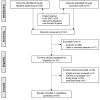Antibiotic consumption and resistance of gram-negative pathogens (collateral damage)
- PMID: 30671336
- PMCID: PMC6301726
- DOI: 10.3205/id000040
Antibiotic consumption and resistance of gram-negative pathogens (collateral damage)
Abstract
Antibiotics are commonly prescribed in community and hospital care. Overuse and misuse favors emergence and spread of resistant bacteria. The ATC/DDD methodology is commonly used for presenting the drug utilization data. In primary care, the consumption is usually expressed in DDD per 1,000 inhabitants per day, in hospital, preferably in DDD per 100 bed days and DDD per 100 admissions. The alternative metric is days of therapy (DOT), which needs IT support. Antibiotics have ecological adverse effects at individual and population level. Antibiotics select resistant bacteria among pathogens and normal flora. Broad-spectrum antibiotics, low dosage and prolonged antibiotic therapy favor the development of resistance. Although total use of antibiotics in hospital is much less than in the community, the intensity of use magnified by cross infection ensures a multitude of resistant bacteria in today's hospitals. Reversal of resistance is complex and might persist for many years despite the introduction of antimicrobial containment and stewardship programs.
Figures
References
-
- European Centre for Disease Prevention and Control. Antimicrobial resistance surveillance in Europe 2014. Annual Report of the European Antimicrobial Resistance Surveillance Network (EARS-Net) Stockholm: ECDC; 2015. Available from: https://ecdc.europa.eu/sites/portal/files/media/en/publications/Publicat....
-
- European Centre for Disease Prevention and Control. Point prevalence survey of healthcare-associated infections and antimicrobial use in European acute care hospitals. Stockholm: ECDC; 2013.
Publication types
LinkOut - more resources
Full Text Sources
Research Materials


